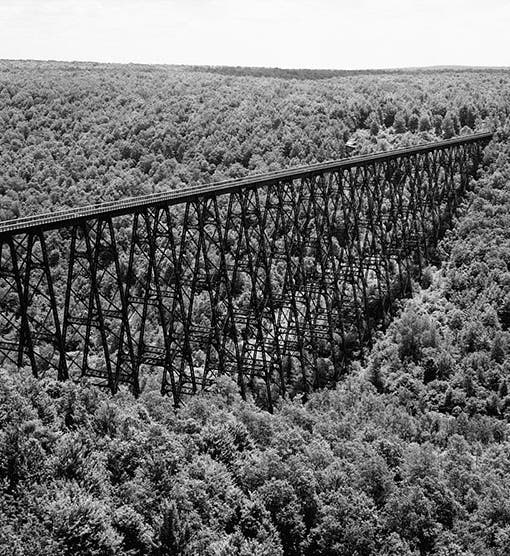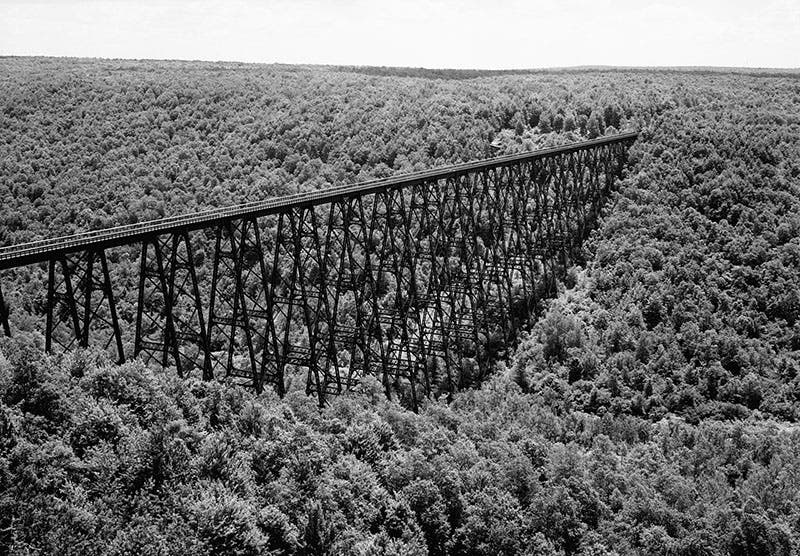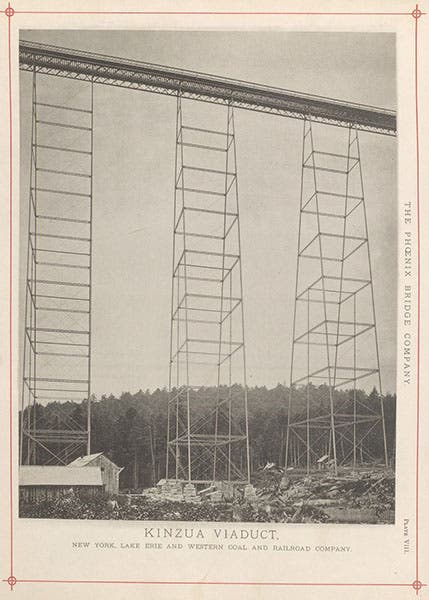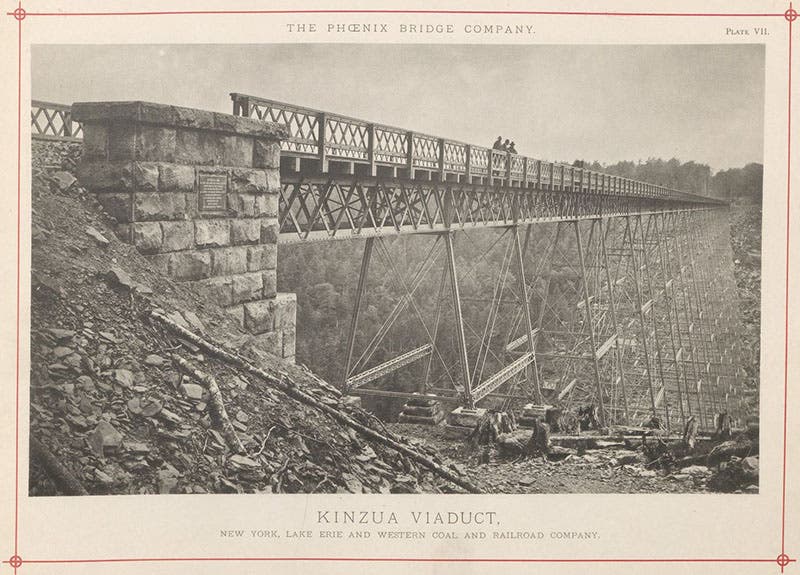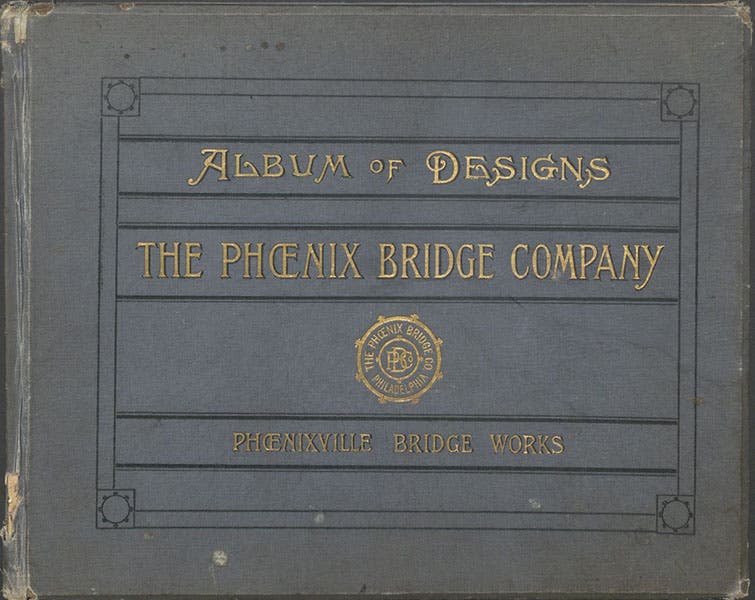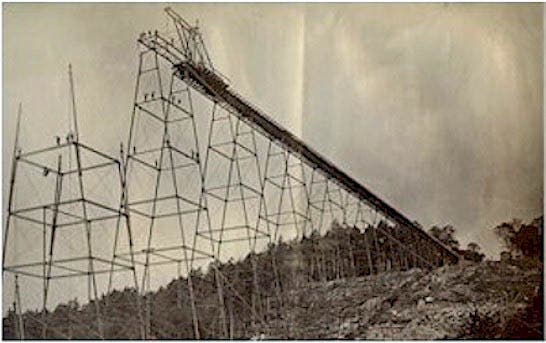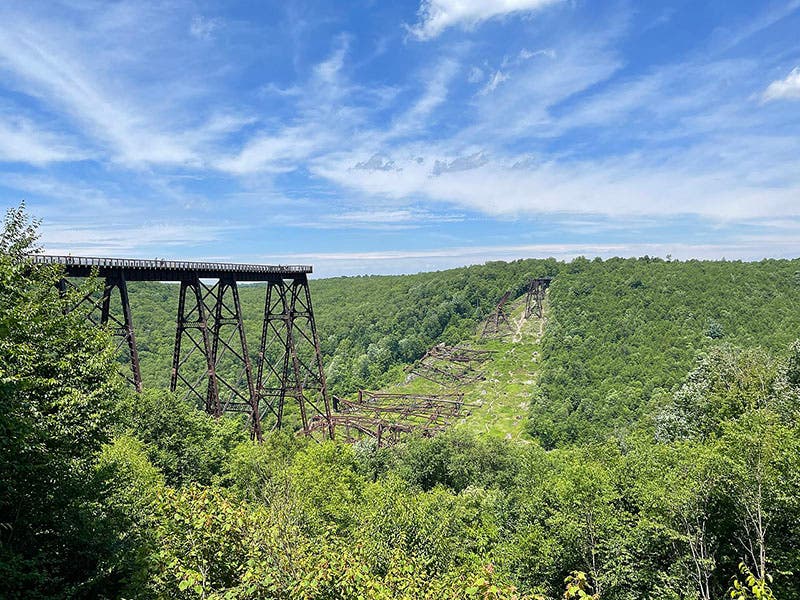Scientist of the Day - Kinzua Viaduct
The Kinzua viaduct, a wrought-iron tower-trestle railroad bridge in northwestern Pennsylvania, opened for traffic on Aug. 29, 1882. This spectacular piece of ironwork, over 2000 feet long and 300 feet above the valley floor, was designed by Octave Chanute (who designed the first bridge over the Missouri River, the Hannibal Bridge, right here in Kansas City), and it was constructed by the Phoenix Bridge Company of Pennsylvania. The viaduct was commissioned by Thomas L. Kane, president of the New York, Lake Erie and Western Railway, who wanted to get to the coal fields of Elk County by the most direct route, which involved crossing the Kinzua valley.
The design was unusual in that the roadway was held up by 20 slim iron trestle towers that were freestanding and unconnected to each other. Each leg of each tower stood on and was bolted to a limestone pier, the stone for which was quarried locally. The towers and roadway were built in sections at the Phoenixville plant, so that they could be erected by construction crews with no further ironwork. The lack of inter-connecting braces made the structure relatively simple to build.
A crew of 100 men assembled the Viaduct (and built the piers) in a little over four months, between May and August, 1882, which seems quite amazing – neighbors down the street have been building a house for the past 15 months and aren’t even close to being done. The viaduct went up so rapidly because of an ingenious construction technique used by Phoenix – Once the first tower had been built, they used a traveling crane on the advancing roadway to erect each subsequent tower, until all 20 towers were in place (fifth image). When completed, the Kinzua viaduct was the tallest and the longest railroad bridge in the world, although it didn't hold that title for long.
The Phoenix Bridge Company published an Album of Designs in 1885, showcasing their products, and we have two copies of this book. We show you two plates illustrating the Kinzua Viaduct from our copy 2, for reasons explained below, as well as the decorative front cover, because it is, well, decorative.
Locomotives and coal-cars grew bigger and heavier in the years after 1882, and by 1900, the Kinzua Viaduct was at its load limit. So a different company was contracted to replace all the iron towers with heavier steel ones, which they did, again amazingly, without taking down the old viaduct – they simply replaced the tower at each end with a sturdier steel one, and then moved toward the center, replacing the old towers one by one. The bridge retained the same basic form and limestone base and remained in operation for another century. We show a photo taken in 1971 of the replacement viaduct (first image).
Viaduct lovers everywhere were saddened when this beautiful structure fell victim to a tornado in 2003, which knocked down 11 of the towers and left the bridge in a shambles on the valley floor. It was soon decided to make the best of a bum deal and turn the remaining towers and roadway into a tourist attraction, in what was already Kinzua Viaduct State Park. An observation platform was built at the end of a walkway over the last standing tower. It is not as high as some of the towers that stood in the center of the valley, but it is lofty enough to give quite a spectacular view, not only of the valley floor, but of the twisted remains of the tornado-scattered steel towers (sixth and seventh images). Unfortunately for would-be sightseers, it was recently announced (April 2024) that the observation deck is closing to the public until 2027 to replace parts of the towers and walkway.
For those of you who have the time and interest, there is an informative half-hour video about the Kinzua Viaduct, produced in 2004 for Pennsylvania Public Television by Penn State University. There are some great photos in this video of the viaduct under construction, the replacement of the towers in 1900, and the devastation wrought by the tornado in 2003. One of the commentators in the video is Eric DeLony, at the time the head of Historic American Engineering Record and very active in helping preserve historic bridges, especially in Pennsylvania. Mr. DeLony had a superb library of books on historic bridges. He often made inquiries of the Linda Hall Library staff and got to know Bruce Bradley, our Rare Book Librarian at the time. In 2012, DeLony decided to give his entire library to our Library, over 1100 volumes, which can be found in both the Rare Book Collection and in the general collection. One of the volumes he gave us was the Phoenix Bridge Company’s Album of Designs, which is extra-illustrated with 13 additional plates printed after 1885, and which we used to illustrate today’s post. We displayed the Kinzua Viaduct plates from copy 1 in our 2004 exhibit, Centuries of Civil Engineering, which is still available online.
William B. Ashworth, Jr., Consultant for the History of Science, Linda Hall Library and Associate Professor emeritus, Department of History, University of Missouri-Kansas City. Comments or corrections are welcome; please direct to ashworthw@umkc.edu.

